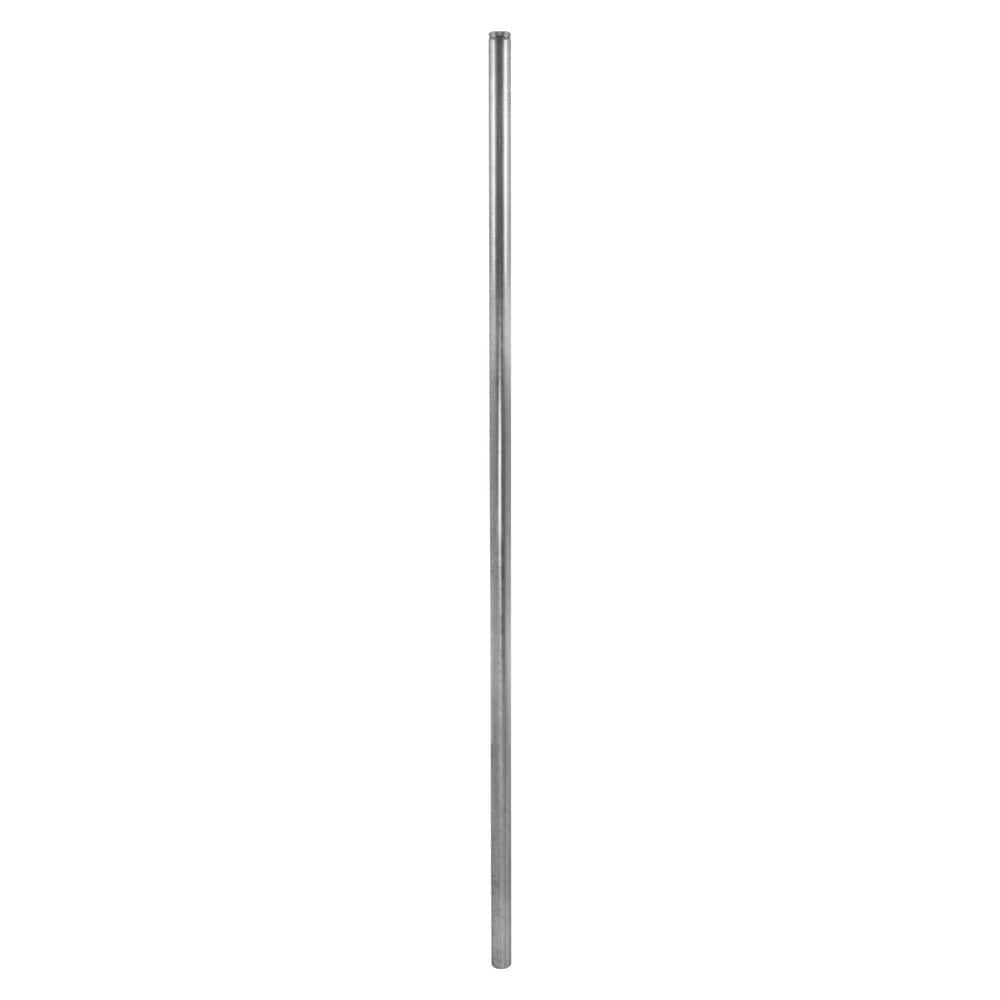I plan on doing most of the installation myself, and had a couple questions. Does the mounting pole double as a ground, or do I need to drive a second ground line? How deep does the mounting pole need to be in the ground? I’ve got limestone a few feet down, though depth varies a bit across the lot.
The mounting pole does NOT double as a ground, at least not according to code. I think part of the reason is that you typically paint the pole and/or bury it in concrete, so it really does not make good contact with a ground. What you should do instead is ground the pole using a ground wire (preferably copper) to a ground rod maybe two to four feet from the pole and then continue that ground wire to the ground rod under your electric meter and clamp it to that ground rod (alternately you can use a split bolt type connector to connect the ground wire to the ground wire going to your house ground rod, that comes from your house electric panel). What you are not supposed to have is two independent ground rods that are not connected to each other.
For the purposes of complying with code it is more important to run a ground wire from the dish to your house ground than to have a ground rod near the dish but I like having a ground rod close to the dish for a couple of reasons, first in the event that lightning hits the dish it gives it a more direct path to ground, and second it just gives you a better ground system for both your home and your dish. In fact if it were a fairly long run I'd be inclined to drive a ground rod every 25 feet or so just to dissipate any differential currents. But that is just me. One pro tip, find out where the local electricians get their electrical supplies - you may be able to find ground rods and the clamps that attach to them at a significantly lower price than what you will find in a big box store. Although if you have a local scrap metal salvage yard it's not unheard of to find used ground rods there, just make sure the galvanized coating is not too badly damaged. Speaking of scrap metals yards, those can also be great places to find pieces of metal pipe of the same diameter as a dish pole (typically 3½ inches for C band), they may be rusty but can be sanded or wire brushed and then painted with Rust Destroyer followed by a coat of paint.
As far as post installation, I know some receivers can direct a dish rotator, but do I need to purchase an external box as well for that, or does it pass the signal through the coax?
I'm not the best person to answer that, all my dishes are fixed on a single satellite except for one which technically can be moved but hasn't been for years.
How does latitude affect signal? I’m assuming that closer to the equator puts less distance, and less atmosphere between your dish and the satellite, but how drastically does that translate to dish and signal size? I’m in the Dallas area, so fairly southern.
I would think how close you are to the equator would not make a big difference but what you are more concerned about is the coverage area of a satellite. For example, where I live in the northern US I can get a great signal from the Canadian satellites, however down in Texas you would be much further from their coverage area so you may need a larger dish to receive those satellites or in some cases simply may not be able to receive them at all.
Final question, how do I even get a C-Band dish in 2020? I’d prefer used as the new ones I’ve seen are a bit spendier then I’m willing ask my wife to let me part with on a hobby. Frankly I’m also not sure where to even find one aside from just driving around outside town and trying to peep a glance at peoples backyards.
Your last thought is pretty much how I have got all my dishes. A few notes: I have found steel mesh dishes are the best but check to make sure they are not too rusty or dented, preferably before you even talk to the homeowner (a good pair of binoculars may be helpful), I have one dish that's more auto body filler than steel in the lower part and it doesn't give me great signal strength. If you see one that looks like someones been hitting baseballs into it I'd take that only as a last resort. When you approach the homeowner, just ask if they are still using their dish, if they say no then ask if they would like to get rid of it. I always explain that I want to get one to use for satellite reception and that I am not a scrapper (a lot of people don't care for scrappers). You will get all kinds of reactions. Some people think they are sitting on a piece of gold and will try to charge you big bucks - just politely walk away from those. I have never paid more than $20 for a dish and that was a 10 foot Channel Master in great shape. Some people are happy to get rid of the dish but will try to sell you their old receiver, and you have to explain that all satellite TV is now digital so just as their old TV won't work anymore, neither will an old satellite receiver (it might have some value as a dish mover if it has that circuitry built in, but that's about it). The best ones are where you get a woman who is so sick of looking at that "big ugly dish" that she thinks you are an angel sent from heaven or something, in fact the reason I wound up with the really rusty dish was because the woman begged me to take it, she hated it! If no one is home, leave a note in the door, just say something like "If you are no longer using your big satellite dish in your back yard and would like to get rid of it please call me. I want to use it for satellite reception, I am not a metal scrapper. My number is..." I have left notes like that and got a call after a week or a month, in one case it was nearly six months if I recall correctly. And then there is the occasional crab who resents the fact that you have rung their doorbell, again just politely walk away.
Big fiberglass dishes are better than nothing (maybe) but there are three problems with them. First, the damn things are usually HEAVY, even a smaller one can break your back. If it is still on the pole plan on bringing two weight lifters or three or four guys with normal strength to get it off the pole and onto your truck or trailer. If it is a really big one you may need to rent a crane! Second, they tend to attract black mold (especially if there are oak trees around) which makes them look extra ugly - if you get one be prepared to pressure wash and maybe paint or stain it before you put it up (I have used forest green colored stain and it works really well to make the dish "blend in" more, though obviously you'd want to match the color to the area). Third, for some odd reason the metal parts tend to be much rustier than on equivalent size metal dishes, though I have never understood why.
When you go to get a dish bring penetrating oil, a propane torch, a set of socket wrenches, one or two big crescent wrenches, a breaker bar if you have one, and a screwdriver with tips. Also it you have foolishly said you would take the pole, bring shovels, a sledge hammer, and a really strong friend if you have one (more than one if it's a fiberglass dish). I have never taken the pole because they are always set in concrete and it is easier to just go get another pole at the scrap metal yard, then again if I had an electric or gas powered jackhammer to break up the cement I might feel differently. Also you obviously will need a trailer or truck with a large enough bed. Note that in many states a ten foot dish is technically considered a wide load and if you don't have a permit and whatever else is required for wide loads in your state you could get ticketed, so try to plan a route in advance that keeps you on the back roads and off the major highways. Tie it down well (you don't want it flying off the back of the truck or trailer in the wind) and go slow. And if you are hauling a ten foot dish (or larger) and a line of cars starts to form behind you, find a place to pull over and let them by so you don't get someone so irritated that they get on their phone and call the local police to report you. You might prefer to partially disassemble the dish prior to hauling (especially if you need to travel on major highways) but that can be easier said than done because the bolts may all be very rusty (which is where the penetrating oil and torch can come in handy). If you do disassemble, make sure you label all the sections first to you can reassemble them in the same order.
In our area one of the companies that installed satellite dishes also did tree trimming and therefore had bucket trucks, so they thought nothing of putting dishes on high poles. Be very careful about asking about those because the higher they are, the lower the chance that you will be able to get them down without injuring yourself, damaging property, or bending the dish irreparably (in which case maybe you do become a scrapper). You need to be able to raise the dish off the pole and then lower it to the ground safely. As a ham radio guy you may have some experience in raising tower sections which might be helpful, but remember that a dish might be a lot heavier than a tower section. With the homeowner's permission you can back your truck or trailer up to the pole and maybe gain a little height to stand on, but if you don't have access to any heavy equipment I would try to ask yourself "how much trouble am I going to have getting this thing down?" before approaching the homeowner. Sadly those are sometimes the people who most want to get rid of their "big ugly dish" but you have to think about the chances of personal injury and liability (if you drop a big heavy fiberglass dish on a house or garage and it damages the roof the homeowner is going to expect you to pay, and morally you really should pay for any damage you cause). Also, in rural areas be careful where you drive; avoid driving over septic tanks, drain fields, old wells, etc. or you could cause vehicle or property damage.
That's about all I can think of and anyway I don't want to write a book here! Hope it helps.



